EDUCATION
Arnold Kling Substack: A Deep Dive into Insightful Economics
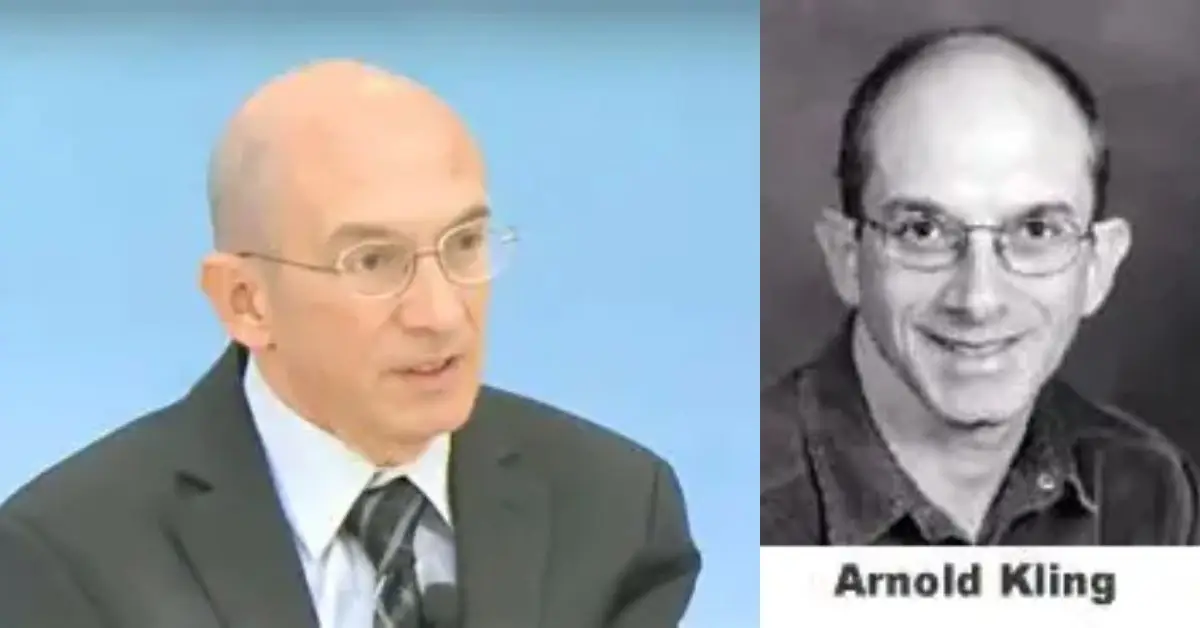
Arnold Kling Substack has become a compelling source for readers who seek nuanced takes on economics, politics, and society. Written by economist and policy analyst Arnold Kling, this platform offers analytical essays rooted in decades of experience and academic rigor. For followers of thoughtful libertarian-leaning commentary, Kling’s Substack has emerged as a beacon of intellectual depth and balance.
In today’s crowded digital space where short-form, superficial takes often dominate, Arnold Kling’s content stands out. His approach to tackling complex societal issues makes this Substack a go-to resource for economists, students, journalists, and policy enthusiasts. Below, we’ll explore its core value, strengths, usability, comparison with similar platforms, and why it’s gaining traction as a reliable voice in modern discourse.
Understanding Arnold Kling’s Background and Philosophy
Arnold Kling, a former economist at the Federal Reserve and a prolific author, holds a PhD in economics from MIT. He has long been a critic of oversimplified narratives in public policy. Kling’s writing philosophy is rooted in what he terms the “Three-Axes Model,” which classifies political thinking across progressive, conservative, and libertarian lines. His Substack reflects this framework, offering readers a multidimensional lens through which to interpret events.
The Arnold Kling’s Substack consistently delivers essays that are:
- Deeply analytical
- Structured to challenge mainstream biases
- Often exploring overlooked facets of policy debates
Kling believes that “civic discourse is dysfunctional” and aims to rebuild it through education and respectful critique. This mission shapes every post, making the Substack intellectually refreshing and thought-provoking.
Why the Arnold Kling Substack Stands Out
Unlike many platforms focused on entertainment or polarized rhetoric, Arnold Kling’s Substack emphasizes clarity and civil engagement. Each essay is meticulously crafted, often based on economic principles, historical analogies, and contemporary political trends.
Key Strengths:
- Analytical Depth: Kling avoids sensationalism, opting instead for calm, evidence-based reasoning.
- Contextual Insight: He often refers to long-term patterns in economics or political theory, giving readers a bigger-picture perspective.
- Reader Engagement: Through thoughtful commentaries, readers are encouraged to explore multiple viewpoints.
Sample Topics Include:
- Why inflation expectations matter more than inflation itself
- The failures of centralized planning in public health
- Revisiting libertarian principles in a post-pandemic world
- Educational reform through market-driven models
Each of these posts reflects Kling’s commitment to educating readers, rather than inflaming emotions.
Audience Appeal: Who Should Read Arnold Kling Substack?
The Arnold Kling’s Substack is ideal for readers who:
- Appreciate long-form intellectual content
- Are interested in economic theory, libertarian thought, or public policy
- Prefer respectful, evidence-driven debate over partisanship
- Seek nuanced commentary on current events
Whether you’re an academic, journalist, policymaker, or simply an informed citizen, Kling’s work offers something of lasting value.
Comparing Arnold Kling Substack with Other Commentary Platforms
To understand where the Arnold Kling Substack fits within the ecosystem of economic commentary, consider the table below:
| Feature | Arnold Kling Substack | Traditional Blogs | News Commentary Sites | Academic Journals | Video Platforms |
| Cost | Free or subscription-based | Often free | Free with ads | Subscription-only | Free |
| Efficiency | High (direct insights) | Medium | Varies | Low (dense format) | Low (time-heavy) |
| Ease of Use | Excellent (email & site access) | Good | Good | Poor | Excellent |
| Expertise Level | High (PhD-backed) | Varies | Varies | High | Low to medium |
| Engagement Quality | Thoughtful discussions | Mixed | Often emotional | Academic-only | Visual-heavy |
Kling’s Substack offers a rare mix: expert-level knowledge without academic jargon, user-friendly formatting, and a clear focus on substance over style.
Core Themes Explored on Arnold Kling Substack
The Limits of Technocracy
One recurring topic on the Arnold Kling Substack is the critique of technocracy—rule by experts without democratic accountability. Kling argues that technocratic policies, while well-intentioned, often fail due to complexity and unintended consequences. He highlights that decentralized decision-making, rooted in market principles, often yields better results.
“Decentralization is not a flaw in markets; it’s a feature,” Kling writes.
The Importance of Moral Frameworks in Policy
Kling emphasizes that policy debates are rarely about facts alone. Instead, they are moral discussions shaped by how different groups perceive justice and responsibility. His “Three-Axes Model” illustrates this well, showing how progressives, conservatives, and libertarians interpret events through unique moral lenses.
Economic Forecasting and Humility
Another theme is the inherent difficulty of economic forecasting. Kling often quotes economists like Friedrich Hayek to support his view that knowledge is decentralized and uncertain. This humility sets his content apart from the more confident but frequently wrong predictions in mainstream media.
Readability and Accessibility
Despite the intellectual nature of his content, the Arnold Kling Substack remains accessible. Kling avoids jargon and often uses analogies from history, literature, and pop culture to make complex topics understandable.
Format and Structure
Each post follows a clear, reader-friendly format:
- Introduction of issue
- Context and historical background
- Multiple perspectives (often conflicting)
- Conclusion with takeaways
Transition words are used generously, helping readers follow even the most intricate arguments with ease.
Substack as a Publishing Platform
While the focus here is on Arnold Kling Substack, it’s worth understanding why Substack itself is a popular medium for independent thinkers. Substack allows authors to:
- Retain creative control
- Connect directly with audiences
- Offer premium content without third-party interference
This model aligns perfectly with Kling’s desire to escape institutional gatekeeping. Instead of writing for editorialized think tanks or journals, he delivers straight to readers who value substance over style.
Community Interaction and Growth
Kling encourages respectful dialogue. Many posts invite comments, and he often responds, creating a mini-think tank environment within each thread. Readers aren’t just consuming—they’re contributing.
This interactive element distinguishes Arnold Kling Substack from static academic papers or mainstream op-eds. Over time, it fosters a sense of community grounded in intellectual curiosity rather than tribal allegiance.
Conclusion
Arnold Kling Substack is more than just another opinion platform—it’s a curated space for those who crave intellectual rigor, balanced analysis, and respectful discourse. Starting from a strong academic foundation, Kling brings readers into the world of economics and public policy without condescension or partisanship.
In a digital age saturated with noise, this Substack provides clarity. It teaches, challenges, and elevates the quality of online discussion. Whether you’re a student or a seasoned economist, engaging with this platform will refine your thinking and broaden your perspective.
FAQs
What topics does Arnold Kling Substack cover?
Arnold Kling covers economics, politics, education reform, healthcare, libertarian theory, and cultural analysis with a non-partisan, analytical tone.
Is Arnold Kling Substack suitable for beginners?
Yes. Despite deep content, the writing is accessible and avoids unnecessary jargon, making it useful for both newcomers and experts.
How often is Arnold Kling’s Substack updated?
Typically, new essays are posted weekly or biweekly, depending on the topic’s depth and current events.
Is there a cost to subscribe to Arnold Kling’s Substack?
There are both free and premium (paid) subscription options. Many core essays are available at no cost.
How does Arnold Kling differ from other economic commentators?
Kling emphasizes humility in predictions, moral frameworks in policy, and structured models for understanding political divisions—unlike many commentators who lean heavily into bias or sensationalism.
Can I interact with Arnold Kling directly on Substack?
Yes. The comment sections are often active, and Kling frequently responds, encouraging respectful and thoughtful dialogue.
EDUCATION
What is Samigo App Explained: Complete Beginner’s Guide 2025
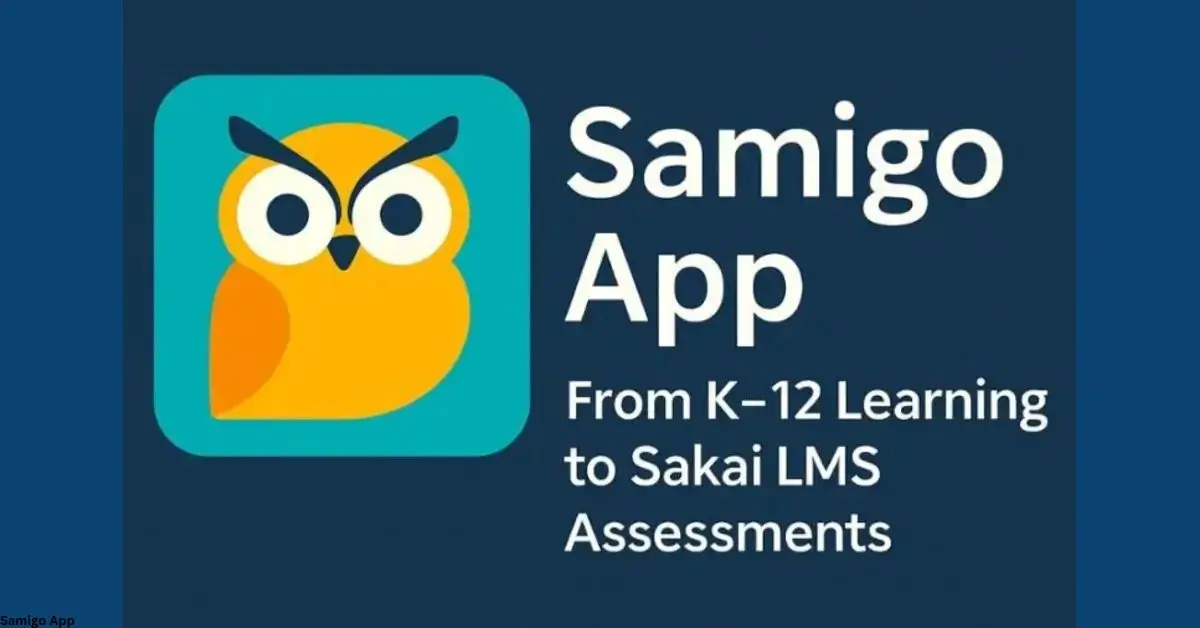
In today’s learning and work world, tools need to be smart, fast, and secure. That’s why many people search for the Samigo app but here’s the catch. Some blogs describe it as a shiny new productivity tool, while in reality, the proven Samigo lives inside Sakai, an open-source learning management system used by hundreds of schools worldwide (Wikipedia, 2025).
Do you know? Only 2% of U.S. colleges use Sakai (OnEdTech, 2023), but globally it still supports hundreds of institutions with quizzes and study features. Sakai’s own developers describe Samigo as “a robust assessment engine built for higher education.”
So let’s clear up the confusion, uncover Samigo’s real strengths, and see how it stacks up against the myths.
Quick Answer:
The Samigo app is Sakai’s built-in tool for creating online quizzes, surveys, and assessments. It is not a verified standalone mobile or productivity app. Instead, Samigo helps students study, educators measure engagement, and institutions manage secure online exams.
What is the Samigo App Used For?
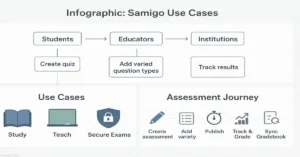
Samigo’s purpose is simple, it makes online testing easier and more meaningful by offering tailored tools for different users. Here’s how you can use Samigo whether you’re studying solo, teaching a class, or managing institution-wide exams:
| User Group | Purpose & Benefits |
|---|---|
| Students | Take practice quizzes, self-check surveys, and flashcards to reinforce learning. Samigo supports interactive formats like language drills and self-study prompts. (sakaiproject.atlassian.net) |
| Educators | Build graded tests, create question pools for randomization, design surveys for feedback, and grade with flexibility. You can even include projects, compositions, and language drills. (sakaiproject.atlassian.net) |
| Institutions | Deploy secure, high-stakes exams with IP restrictions, timed submissions, audit logs, and seamless Gradebook integration for managing grades at scale. (sakaiproject.atlassian.net, longsight.screenstepslive.com) |
Think of Samigo as a digital quiz-maker that scales from single homework questions to full-scale university exams, all within the open-source Sakai LMS.
Samigo’s Key Features and Capabilities

Samigo isn’t just multiple-choice. It supports a wide range of formats that many quiz tools skip.
Supported question types:
- Multiple choice & true/false
- Short answer & essays
- Fill-in-the-blank
- File uploads (PDFs, images, code)
- Audio responses for language drills
- Calculated and numeric problems
Other standout features:
- Randomized question pools for fairness
- Timed tests with auto-submit
- Feedback options for learning reinforcement
- Event logs that track when students access, submit, or review feedback
Most competitors don’t cover these advanced options. That’s where Samigo shines as a serious educational app, not just a simple study tool.
Is There a Standalone Samigo App?
Here’s where the confusion comes in. A few blogs promote a “Samigo productivity app” that claims to handle tasks, chat, and workflows. But no verified listing exists in the Apple App Store or Google Play.
Myth vs Fact:
- Myth: Samigo is a flashy new all-in-one app.
- Fact: Samigo is part of Sakai LMS and powers online quizzes in schools.
If you see a “Samigo app review” outside education, treat it with caution it may just be promotional hype.
How Does Samigo Compare to Other Tools?
Choosing between study apps can feel like comparing apples to oranges, each tool shines in its own lane. Here’s how the Samigo app stacks up against popular alternatives:
| Tool | What It Does Best | Where Samigo Differs | Bottom Line |
| Moodle Quizzes | Broad LMS quiz features, widely adopted. | Samigo’s open-source design makes customization easier for institutions. | Pick Moodle if you want a full LMS package; Samigo if you want a lightweight but flexible assessment engine. |
| Quizlet | Flashcards and student-first practice. | Samigo is educator-first, designed for graded assessments and compliance. | Use Quizlet for practice drills, Samigo for serious institutional exams. |
| Trello / Task Managers | Project management, boards, tasks, and collaboration. | Samigo is built for learning, not task management. Remote teams may miss Kanban boards. | Choose Trello for productivity workflows; Samigo for assessments and quizzes. |
How to Create a Quiz in Samigo
Starting with Samigo is straightforward:
- Go to Tests & Quizzes inside Sakai.
- Choose Create New Assessment.
- Add parts (sections) and questions.
- Set release date, due date, and time limits.
- Publish and link results to Gradebook.
Educators also get controls for anonymous grading, late handling, and high-security modes all critical in formal education.
How Secure is the Samigo App?
Security is where institutions pay close attention.
- Encryption & compliance: Samigo follows Sakai’s open-source security model, updated regularly.
- Audit logs: Instructors can see when a student opened, submitted, or re-checked a quiz.
- Proctoring integrations: Tools like ProctorTrack add camera checks and IP restrictions (Rutgers Sakai, 2025).
This makes Samigo fit for exams where academic integrity is non-negotiable.
Who Benefits Most from Samigo?
- Students: Practice quizzes, feedback, study tracking.
- Educators: Engagement analytics, flexible grading.
- Institutions: Secure exams at scale, LMS integration.
- Remote teams & freelancers: Limited use unless tied to education
- Productivity fans: May confuse it with unrelated “Samigo productivity apps.”
If you’re a student or teacher, Samigo works best. If you’re chasing an all-in-one workflow app, this isn’t it.
Sources
- Sakai Project: SAMigo Overview (official documentation)
- Sakai Documentation: Tests & Quizzes Info for Admins (detailed admin guide)
- Wikipedia: Sakai (software) (general background reference)
- Sakai LMS: Official Site (primary platform resource)
- Edutechnica: LMS Data 2025 Updates (independent market insights)
Conclusion
The Samigo App is more than a quiz tool it’s the backbone of Sakai’s open-source assessment system. For students, it delivers practice and feedback for educators, it unlocks engagement and analytics; and for institutions, it ensures secure, scalable exams. Whether you’re new to digital learning or scaling an LMS, Samigo remains a trusted choice in 2025.
FAQ’s
Is Samigo free?
Yes. Samigo is part of Sakai LMS, which is open-source. Institutions may still pay hosting or support fees.
Does the Samigo app have AI quizzes?
Not directly. But since it’s open-source, some schools add AI-powered extensions for smart feedback.
Can I use Samigo on my phone?
Yes. Sakai has a responsive site, but there’s no standalone Samigo mobile app.
How does Samigo enhance student engagement?
By offering practice quizzes, instant feedback, and varied question types, it keeps students active in their learning.
What are Samigo’s hidden features?
Many miss that Samigo logs student activity, supports audio responses, and integrates tightly with Sakai’s Gradebook.
Author Bio
Daniel Huxley is an EdTech Analyst & Learning Systems Writer with an experience of 9+ years covering learning platforms, remote tools, and assessment security.
EDUCATION
What Is Learning the 9 Most Amazing Things 5-Year-Olds Accomplish 2020 Stjcc?
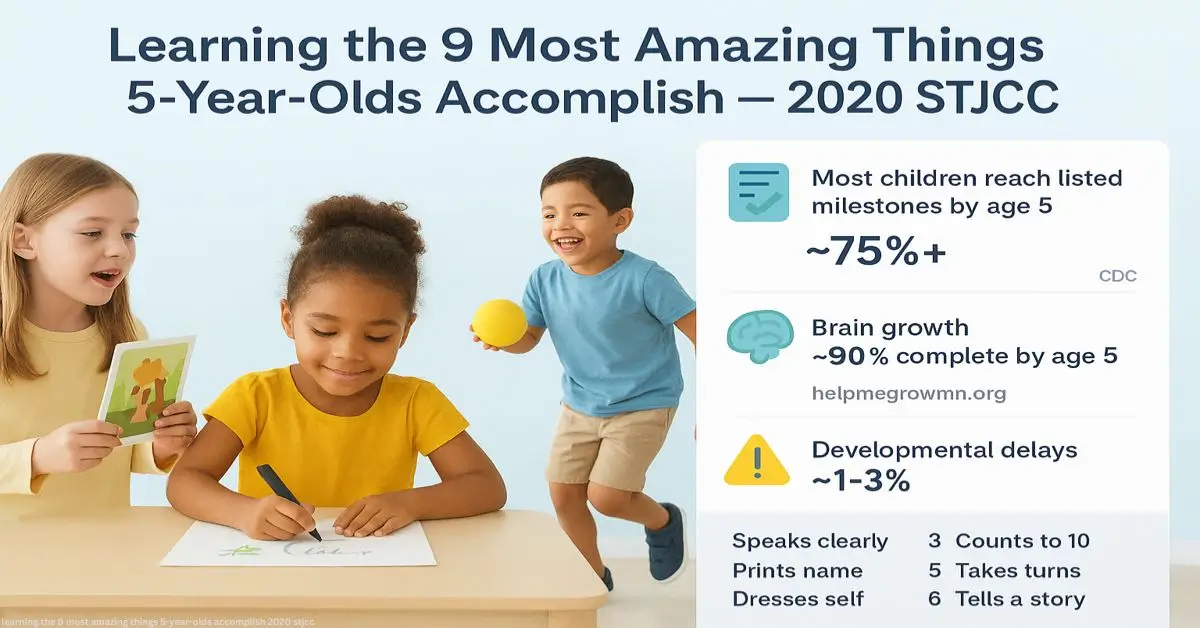
If you’re a parent, teacher, psychologist, or childcare leader, you already know that five-year-olds are little dynamos, curious, imaginative, and growing at warp speed. But what exactly are they capable of, especially against the backdrop of 2020’s upheaval? Let’s cut through the noise and explore nine awe-inspiring achievements identified by STJCC (South Tampa/St. Joseph’s Jewish Community Center). This guide is designed for everyone in the early child development ecosystem providing clarity, confidence, and practical next steps.
Quick Answer
Yes, “learning the 9 most amazing things 5-year-olds accomplish 2020 STJCC” highlights key developmental milestones across language, social-emotional, physical, cognitive, creative, independence, digital, resilience, and pre-academic domains, giving parents, educators, and professionals a clear snapshot of this critical age.
9 Amazing Milestones Every 5-Year-Old Conquers

At age five, children take one of the biggest leaps in early childhood mastering language, social skills, problem-solving, and creativity all at once.
1. Rapid Language & Cognitive Leap
Five-year-olds regularly use 2,000–5,000 words, tell multi-part stories, and grasp abstract ideas like time and cause-effect (Evolve Feed, Wikipedia, illinoiscaresforkids.org). They ask “why” over and over a sign of deep curiosity and critical thinking.
2. Flourishing Social & Emotional Growth
Kids this age develop what’s known as theory of mind recognizing others have different feelings and perspectives (Big Write Hook, ColumbiaDoctors). They manage emotions better, express empathy, and are mastering friendship rules like taking turns and resolving disputes.
3. Problem-Solving & Mathematical Awareness
Beyond rote counting, five-year-olds explore patterns, sequencing, and simple math concepts recognizing “more/less,” sorting shapes, and applying logic in play (Evolve Feed, illinoiscaresforkids.org).
4. Physical Coordination: Gross & Fine Motor Skills
They’re balancing, hopping, skipping, drawing triangles, using scissors, and even starting to write letters actions that lay the groundwork for school readiness (CDC, ColumbiaDoctors, Wikipedia).
5. Thriving Creativity & Imaginative Play
Five-year-olds dive into pretend worlds playing superheroes, creating narratives, building art scenes. This imaginative play strengthens problem solving, storytelling, and cognitive flexibility, something often overshadowed by academic focus.
6. Independence & Self-Care Skills
At this age, kids dress themselves, follow routines, help prepare snacks, and tidy up after activities. These daily responsibilities teach executive function and confidence.
7. Digital Awareness & Adaptation (Thanks to 2020)
Remote learning pushed five-year-olds to become tech-savvy: they navigated Zoom, digital platforms, and educational apps with surprising ease. Many even began understanding digital safety and the difference between passive and active screen time.
8. Emotional Resilience in Challenging Times
Despite pandemic disruptions, children continued milestone development. Programs like “Mindful Mondays” helped them express feelings, reduce virtual classroom behavioral issues, and build resilience.
9. Early Academic Readiness & Growth Mindset
They begin decoding letters, matching sounds, and asking thoughtful questions showing persistence, enjoyment of learning, and readiness for formal schooling.
Practical Strategies to Support Each Milestone

Language & Cognitive Leap
- Read aloud and ask “why/how” questions.
- Let kids retell stories in their own words.
Social & Emotional Growth
- Role-play empathy (“How would your friend feel?”).
- Use a simple “feelings chart.”
Problem-Solving & Math Awareness
- Play board games with counting or patterns.
- Cook together to explore measurement.
Physical Coordination
- Use puzzles, scissors, and clay for fine skills.
- Encourage outdoor play like biking or skipping.
Creativity & Imaginative Play
- Keep a “prop box” for pretend play.
- Support drawing, painting, and skits.
Independence & Self-Care
- Give small chores like setting the table.
- Use picture charts for routines.
Digital Awareness
- Set clear screen-time limits.
- Choose creative, educational apps.
Emotional Resilience
- Practice short breathing exercises.
- Encourage drawing or journaling.
Academic Readiness & Growth Mindset
- Praise effort as much as success.
- Use magnetic letters or sound games.
The 2020 Snapshot: Tracking Milestone Success Rates in Preschoolers
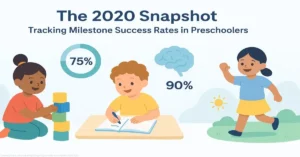
| Milestone Domain | Percent of Children Expected to Achieve by Age 5 | Source & Notes |
| General developmental benchmarks | 75% or more of children reach listed milestones by age 5 (“most children”) | CDC’s guideline approach (PMC, Sensory Health) |
| Brain development completion | ~90% of brain growth occurs by age 5 | First Things First (early childhood research) (First Things First) |
| Prevalence of developmental delays | ~1%–3% of children under age 5 experience developmental delays | Wikipedia summary of global data (Wikipedia) |
Milestone Snapshot Table

| Domain | Typical Capabilities at Age 5 |
| Language & Cognitive Growth | 2,000–5,000 word vocab, stories, abstract thinking |
| Social–Emotional | Empathy, emotional vocabulary, sharing, conflict resolution |
| Problem-Solving & Math | Counting, pattern recognition, logical thinking |
| Motor Skills | Hopping, drawing shapes, scissor use, writing letters |
| Creativity | Imaginative play, art, storytelling |
| Independence | Dressing, routines, helping at home |
| Digital Literacy | Zoom navigation, app use, screen boundaries |
| Resilience | Emotional regulation, adaptation to change |
| Academic Readiness | Letter recognition, number sense, learning engagement |
Common Queries:
What are key milestones for 5-year-olds?
They include multi-step storytelling, advanced social skills, blend of physical coordination, early math understanding, and imaginative play.
How do 5-year-olds learn problem solving?
Through play like building blocks and guided questioning (“What happens if…?”), children experiment, make predictions, and adjust based on results.
Why is creativity strong in preschool children?
Imagination is natural to this age. Without self-consciousness, kids invent stories, characters, and scenarios—nurturing empathy, expression, and flexible thinking.
Which skills show independence at age five?
Dressing themselves, managing routines, helping with chores, and preparing simple snacks—all reflecting growing self-reliance.
How do 5-year-olds develop social skills?
By interacting with peers and adults—learning to take turns, empathize, share, and resolve conflicts with support and modeling.
Sources:
- Centers for Disease Control and Prevention (CDC): Widely trusted for developmental milestone checklists and age-specific guidance.
- American Academy of Pediatrics (AAP): Offers evidence-based information on child health, social-emotional growth, and learning readiness.
- Harvard University’s Center on the Developing Child: Provides deep research into early brain development and how children learn at preschool age.
FAQ’s
How to measure fine motor skills in kids?
Observe tasks like buttons, cutting shapes, drawing letters; CDC has a helpful checklist (CDC).
What emotional changes happen at age 5?
Kids express more emotions, use a richer vocabulary (e.g., anxious, proud), and start self-regulating.
How do teachers track child development milestones?
Through observations, milestone checklists, parent-teacher notes, and structured play assessments.
Which growth markers do doctors check at age 5?
Height/weight metrics, speech/language development, motor coordination, social-emotional and cognitive benchmarks.
What behaviors are normal for age five?
Independent actions, imaginative play, occasional emotion outbursts, asking hundreds of “why” questions, and strong curiosity.
Author Bio
Jamie Fields is a seasoned early childhood content strategist with a background in child psychology (M.Ed). Jamie’s passion lies in translating developmental science into actionable insights for parents, educators, and child development professionals.
You can download a “5-Year Milestone Tracker” for your young one from Playstore.
Also consider watching this video for detailed insights.
EDUCATION
What DoD Instruction Implements the DoD CUI Program?
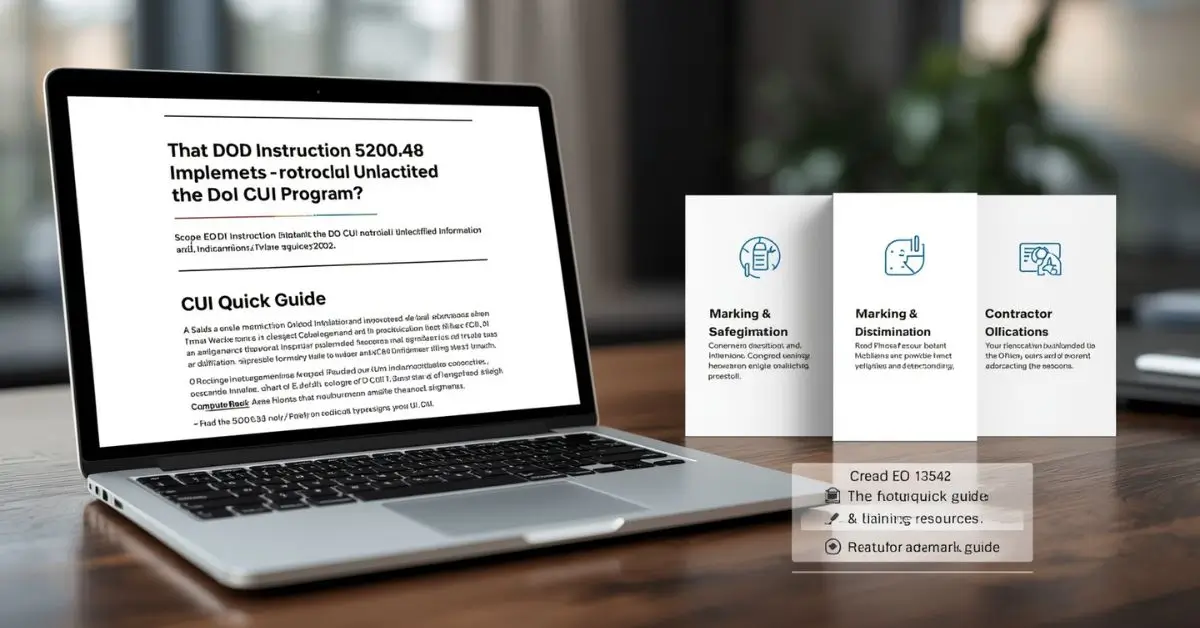
If you work inside the Department of Defense or with it as a contractor, you’ve probably wrestled with the Controlled Unclassified Information (CUI) puzzle. The rules shift, acronyms multiply, and everyone’s worried about making a costly compliance mistake. So what DoD instruction implements the DoD CUI program? And how does it affect your daily workflow, your contract deliverables, or your audit readiness?
The answer is crystal clear: DoDI 5200.48 is the backbone of the entire program. But knowing that isn’t enough. To stay compliant, you need to understand what it mandates, how it connects to DFARS and NIST 800-171, and what pitfalls others are running into. Let’s break it down.
Quick Answer
The DoD Instruction 5200.48, “Controlled Unclassified Information (CUI)”, issued on March 6, 2020, is the official directive that implements the DoD CUI Program. It establishes policy, assigns responsibilities, and sets procedures for safeguarding unclassified yet sensitive government information in line with Executive Order 13556.
If someone asks “what DoD instruction implements the DoD CUI program”, the short answer is always DoDI 5200.4
DoDI 5200.48 Explained: The Core Policy
Which DoD instruction establishes the Controlled Unclassified Information program?
It’s DoDI 5200.48, titled Controlled Unclassified Information. This directive is the single authoritative source for implementing the CUI Program inside the Department of Defense.
Key points inside DoDI 5200.48:
- Policy Alignment: Implements Executive Order 13556 and 32 CFR Part 2002.
- CUI Categories: Replaces outdated markings like FOUO and SBU.
- Responsibilities: Requires each DoD Component to appoint a Component Senior Agency Official (CSAO).
- Training: Mandates initial and annual refresher training for all personnel handling CUI.
- Marking Rules: Establishes standardized banner lines, portion markings, and dissemination controls.
- Contractor Impact: Extends through DFARS clauses 252.204-7008 and 252.204-7012.
This makes DoDI 5200.48 the definitive answer to what DoD instruction implements the DoD CUI program.
Why is DoDI 5200.48 critical for safeguarding unclassified but sensitive information?

Because sensitive data that doesn’t qualify as classified is still a prime target for adversaries. Think personal health information, critical infrastructure data, or sensitive acquisition details. If mismanaged, this information can still harm national security.
By enforcing consistent rules across the Defense Department, DoDI 5200.48 shuts down the guesswork. Instead of every office inventing its own “FOUO” or “SBU” policy, there’s one unified playbook. For anyone asking what DoD instruction implements the DoD CUI program, this consistency is the answer.
Implementation in Action
Steps to implement DoDI 5200.48 across a DoD component
- Appoint a CSAO to oversee the program.
- Inventory and classify all information against the DoD CUI Registry.
- Train employees on marking, safeguarding, and decontrol.
- Update contracts with DFARS clauses.
- Audit compliance regularly and report to USD(I&S).
This operational roadmap reinforces what DoD instruction implements the DoD CUI program in practice, not just on paper.
CUI and Contractors
Do contractors need to follow DoDI 5200.48 for CUI handling?
Not automatically. As cybersecurity expert Jeff Baldwin notes, DoDI 5200.48 doesn’t bind contractors unless it’s written into a contract. For most, it flows down through DFARS clauses and NIST SP 800-171 safeguarding requirements.
How does DoDI 5200.48 integrate with DFARS CUI clauses?
- DFARS 252.204-7012: Requires contractors to safeguard CUI using NIST SP 800-171.
- DFARS 252.204-7008: Ensures contractors confirm system readiness before contract award.
Result: DoDI 5200.48 sets the policy foundation, DFARS ensures it’s contractually enforceable. For defense contractors searching what DoD instruction implements the DoD CUI program, the practical answer lies in these DFARS linkages.
Common Misconceptions

- Myth 1: Contractors must make their entire IT environment CMMC Level 2 compliant.
- Fact: DoD approves the enclave model, so only systems touching CUI must comply.
- Myth 2: DoD mandates Microsoft GCC High.
- Fact: The DoD sets standards, not specific technologies.
- Myth 3: Contractors can mark anything as CUI.
- Fact: Only categories listed in the DoD CUI Registry qualify.
This section clears confusion around what DoD instruction implements the DoD CUI program and how its rules are applied.
How to comply with DoDI 5200.48 training requirements?
Every DoD employee or contractor handling CUI must complete initial and annual refresher training. The official “DoD Mandatory CUI Training” from the Center for Development of Security Excellence (CDSE) covers:
- Identification and categories
- Marking and disseminationcontrols
- Safeguarding procedures
- Decontrol and destruction
Failure to complete training is one of the most common audit findings according to the DoD Inspector General. This further cements DoDI 5200.48 as the answer to what DoD instruction implements the DoD CUI program.
Challenges & Controversies
The 2023 DoD Inspector General Audit flagged major compliance gaps:
- Inconsistent marking (either over-marking or under-marking).
- Incomplete training records across DoD Components.
- Improper use of dissemination controls that limited Congressional oversight.
Even high-level voices have questioned the program’s complexity. Former DNI John Ratcliffe argued that the CUI framework is “vastly overcomplicated.” Yet oversight leaders like Robert P. Storch, DoD IG, stresses the program is essential for national security if implemented correctly.
Sources:
- DoD Issuance Portal – DoDI 5200.48 (Official Source)
DoDI 5200.48, Controlled Unclassified Information (March 6, 2020) - DoD CUI Registry – National Archives Executive Agent Resource
- DoD Inspector General – Audit of CUI Program Implementation
Final Thoughts
For DoD officers, contractors, auditors, and researchers, the answer to “what DoD instruction implements the DoD CUI program” is clear: DoDI 5200.48. But the real challenge isn’t knowing the number, it’s applying it consistently across complex, multi-agency environments.
With DFARS, CMMC 2.0, and evolving audit scrutiny, CUI compliance isn’t just about marking documents. It’s about building trust, safeguarding sensitive data, and proving resilience in an age of rising cyber threats.
FAQ’s
Which DoD instruction establishes the Controlled Unclassified Information program?
DoDI 5200.48, Controlled Unclassified Information, issued March 6, 2020.
Who oversees DoDI 5200.48 implementation?
The Under Secretary of Defense for Intelligence & Security [USD(I&S)].
How does DoDI 5200.48 define CUI decontrol procedures?
It directs officials to decontrol CUI when no longer required by law, regulation, or policy, ensuring unnecessary restrictions are lifted.
What does DoDI 5200.48 mandate for marking CUI in DoD documents?
It mandates standardized header/footer markings, portion markings, and proper use of dissemination controls for every CUI document.
DoDI 5200.48 vs Part 2002: what’s the difference in CUI policy?
- Part 2002 (32 CFR): Government-wide rules from the National Archives (ISOO).
- DoDI 5200.48: DoD-specific rules applying those federal standards across Defense.
Where to find DoD CUI marking requirements?
They’re in DoDI 5200.48 and detailed in the official DoD CUI Registry at dodcui.mil.
Is DoDI 5200.48 updated recently and how to access the latest version?
The latest version was issued March 6, 2020. Updates and changes are published on the official DoD Issuances portal.
Can DoDI 5200.48 guide contractor compliance with NIST SP 800-171?
Yes, it frames the policy environment, but DFARS clauses make NIST compliance mandatory for contractors.
Author Bio
Written by Daniel Cross, a defense compliance content writer with 8+ years of experience in cybersecurity and federal contracting topics. Holds a Master’s degree in Public Policy and has published extensively on DoD compliance frameworks.
-

 GENERAL1 month ago
GENERAL1 month agoRobert Hubbell Wikipedia: What’s His 2025 Biography Guide?
-

 EDUCATION3 months ago
EDUCATION3 months agoJay Kuo Substack: Unpacking the Voice of Legal Insight
-

 EDUCATION3 months ago
EDUCATION3 months agoEconomic Blackout Results: The Financial Domino Effect
-

 GENERAL3 months ago
GENERAL3 months agoDream Cake: A Decadent Delight Worth Savoring
-

 GENERAL3 months ago
GENERAL3 months agoDo You Have to Show ID to Vote in Michigan?
-

 GENERAL3 months ago
GENERAL3 months agoChris Hedges Substack: A Voice of Dissent in the Digital Age
-

 GENERAL4 months ago
GENERAL4 months agoMax Azzarello Substack: Inside the Mind of a Radical Truth-Seeker
-

 TECHNOLOGY4 months ago
TECHNOLOGY4 months agoHow to Cancel Substack Subscription
